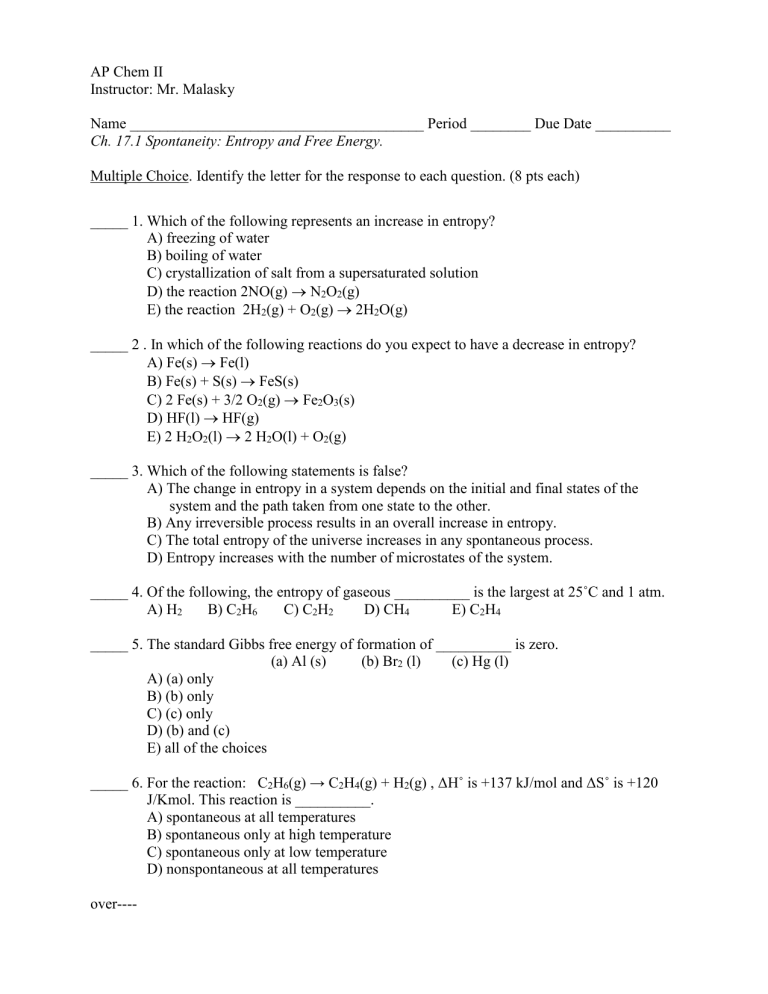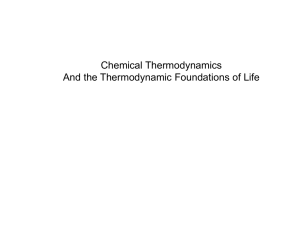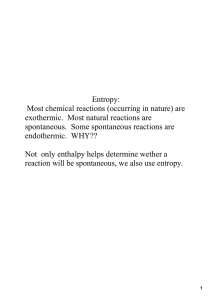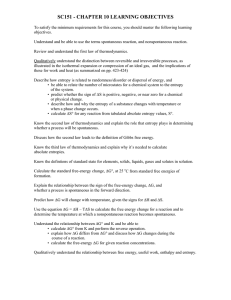
AP Chem II Instructor: Mr. Malasky Name _______________________________________ Period ________ Due Date __________ Ch. 17.1 Spontaneity: Entropy and Free Energy. Multiple Choice. Identify the letter for the response to each question. (8 pts each) _____ 1. Which of the following represents an increase in entropy? A) freezing of water B) boiling of water C) crystallization of salt from a supersaturated solution D) the reaction 2NO(g) N2O2(g) E) the reaction 2H2(g) + O2(g) 2H2O(g) _____ 2 . In which of the following reactions do you expect to have a decrease in entropy? A) Fe(s) Fe(l) B) Fe(s) + S(s) FeS(s) C) 2 Fe(s) + 3/2 O2(g) Fe2O3(s) D) HF(l) HF(g) E) 2 H2O2(l) 2 H2O(l) + O2(g) _____ 3. Which of the following statements is false? A) The change in entropy in a system depends on the initial and final states of the system and the path taken from one state to the other. B) Any irreversible process results in an overall increase in entropy. C) The total entropy of the universe increases in any spontaneous process. D) Entropy increases with the number of microstates of the system. _____ 4. Of the following, the entropy of gaseous __________ is the largest at 25˚C and 1 atm. A) H2 B) C2H6 C) C2H2 D) CH4 E) C2H4 _____ 5. The standard Gibbs free energy of formation of __________ is zero. (a) Al (s) (b) Br2 (l) (c) Hg (l) A) (a) only B) (b) only C) (c) only D) (b) and (c) E) all of the choices _____ 6. For the reaction: C2H6(g) → C2H4(g) + H2(g) , ΔH˚ is +137 kJ/mol and ΔS˚ is +120 J/Kmol. This reaction is __________. A) spontaneous at all temperatures B) spontaneous only at high temperature C) spontaneous only at low temperature D) nonspontaneous at all temperatures over---- _____ 7. For a reaction to be spontaneous under standard conditions at all temperatures, the signs of ΔH˚ and ΔS˚ must be __________ and __________, respectively. A) +, + B) +, C) -, + D) -, E) +, 0 _____ 8. When solid NH4SCN is mixed with solid Ba(OH)2 in a closed container, the temperature drops and a gas is produced. Which one of the following indicates the correct signs for free energy, enthalpy and entropy change. ΔG ΔH ΔS A) - - - B) - + - C) - + + D) + - + E) + - - Free Response. Show all necessary calculations and correct units. (36 pts) 1. Consider the reaction: N2 (g) + 3H2 (g) → 2NH3 (g) The standard heat of formation, ∆Hf◦ of NH3 (g) is -46.2 kJ/mol. The standard free energy of formation, ∆Gf◦ of NH3 (g) is -16.7 kJ/mol. a. What are the values of ∆H◦ and ∆G◦ for the reaction above? b. What is the value of the entropy change, ∆S◦, for the reaction above at 298 K? c. As the temperature is increased, what is the effect on G for the reaction? How does this affect the spontaneity of the reaction? d. At what temperature can N2, H2, and NH3 gases be maintained together in equilibrium, each with a partial pressure of 1 atm?








